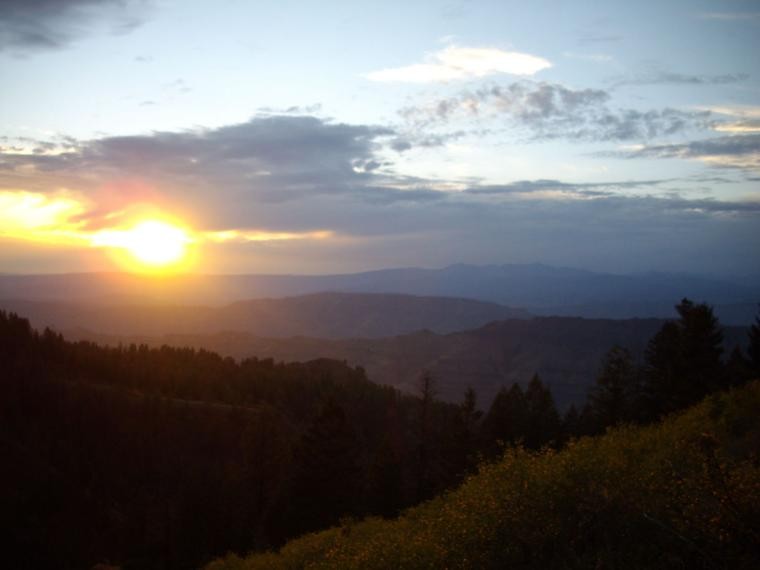Next to sheep hunting, elk hunting is the toughest hunt in Idaho. They live in rough country and they’re tough animals. If you’re hitting it hard by the third day you’re so sore you can’t hardly hunt. So why do people hunt them if it’s so tough? The same reason that makes it tough. Because they live in rough country and they’re cool animals. It gives you a good excuse to get out and hike into areas that you never would.
There’s something cool about being up in elk country. You’re on top of the world in majestic country seeing sights that few people get to see which is all a side benefit.
But how do you be successful, after all, that’s why we elk hunt. We want to get one. I wish that I could give you a five-step plan for guaranteed success. If I had that plan I’d get an elk every year. But I’ll throw out some general rules that should help you be more successful.
SCOUT
The people that are successful year after year scout before season. Even if your family has hunted the same spot for 40 years and you know all of the routes they take when feeding, heading to bed or when spooked, you need to scout. Why? What if a pack of wolves have moved into your drainage and slaughtered everything? Or what if three other camps have decided to hunt in your honey hole this year?
One year a buddy invited me to go hunting with him up by the Rawah Wilderness area. I got there and he said we’ve got to move camp. How come? Unbeknownst to him, the Rainbow Coalition had decided to have a festival there and the day before when he was setting up camp and doing a final scouting, he’d run into some girl in tennis shoes hiking down the trail. And I mean only tennis shoes. Not conducive to a good elk hunting scenario.
While hopefully you may not encounter the above scenario things can change even if you did do due diligence and pre-scout. So the moral to the story is, you need to have at least three spots scouted out to hunt. That way if they aren’t at your first choice — jump. Go to your second choice.
I remember the first elk that I ever got, we moved camp twice before I finally got into the elk at the third camp. If there are no tracks, move. Elk can’t fly so if there’s no tracks, they’re not there. Granted, if you wait long enough some may get moved into your drainage but that’s a big if.
GLASS
I teach “Glassing For Big Game” (glassing = looking around with binoculars) seminars at a number of national sports and hunting conventions and shows and at retail stores and yet every year I’m amazed at how much game I see when I take time to properly glass. Hint: Use good optics. I use Riton Optics 10x42 binoculars and a Lucid Optics spotting scope that I am testing this year. When you take time to glass, it will amaze you as to how much more game you’ll see. But you have to use good optics or you won’t see anything plus bad optics will give you a headache.
SCENT COVER
The more I hunt, the more important I realize that scent cover is important. I like to clip on a couple of the Hunter’s Specialties elk wafers that have cow urine scent on them. They’re strong so let’s just say that you don’t want to be walking downwind of your buddy while he is wearing one.
Also, regardless of how much you cover your scent, always try to stalk in from downwind of your game. Whether it’s elk, deer or bear. And the thermals switch and swirl so it can be confusing. Stalk accordingly.
When setting up to call don’t have brush downwind of you. Set up so they can’t sneak in and scent you and scatter without you even knowing it.
CALLING
With the advent of wolves, most people tell you that elk have gone silent. There’s no use calling anymore. They won’t answer. OK, I agree they have quieted down a good bit but that doesn’t mean that they won’t still come in.
I learned the above by accident. Years ago I took an old buddy elk hunting. He could barely get around even with a walking stick but I’d try to take him out a few days every year. One year near the end before he died, we went to a spot where he’d seen a bull a few days prior. He sat in a spot and I hopped right over the rise 100 yards away. I usually set up and call for 15 to 20 minutes and then move. He said we’d set there about 1½ hours.
Everyone knows the above idea is a dumb idea. Except … the elk. We’d been calling for over an hour. Suddenly I saw a four-point bull sneaking up the mountain. He had not made one peep. I’ve had that happen a lot since then. So yes, elk may not bugle as much as used to when you’re calling but they still come in. Well, good luck!
Tom Claycomb lives in Idaho and has outdoors columns in newspapers in Alaska, Idaho, Utah, Nevada, Colorado and Louisiana. He also writes for various outdoors magazines and teaches outdoors seminars at stores like Cabela’s, Sportsman’s Warehouse and Bass Pro Shop.



